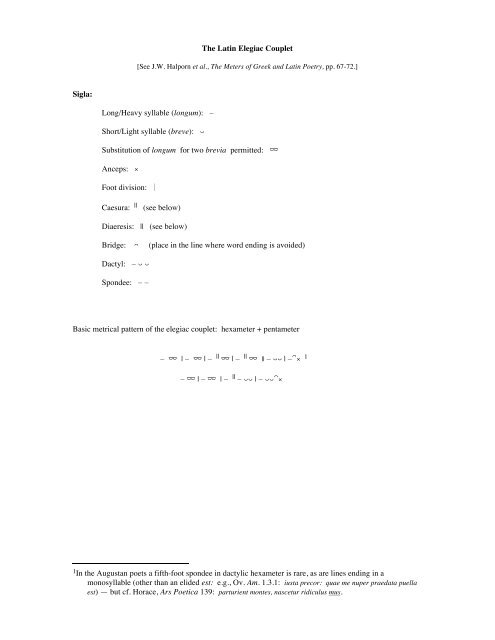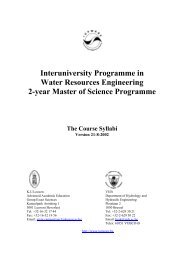Elegiac Couplet - Homepage Usask
Elegiac Couplet - Homepage Usask
Elegiac Couplet - Homepage Usask
You also want an ePaper? Increase the reach of your titles
YUMPU automatically turns print PDFs into web optimized ePapers that Google loves.
Sigla:<br />
The Latin <strong>Elegiac</strong> <strong>Couplet</strong><br />
[See J.W. Halporn et al., The Meters of Greek and Latin Poetry, pp. 67-72.]<br />
Long/Heavy syllable (longum): ‒<br />
Short/Light syllable (breve): ⏑<br />
Substitution of longum for two brevia permitted: ⏔<br />
Anceps: ×<br />
Foot division: |<br />
Caesura: || (see below)<br />
Diaeresis: || (see below)<br />
Bridge: ⌒ (place in the line where word ending is avoided)<br />
Dactyl: ‒ ⏑ ⏑<br />
Spondee: ‒ ‒<br />
Basic metrical pattern of the elegiac couplet: hexameter + pentameter<br />
‒ ⏔ | ‒ ⏔ | ‒ || ⏔ | ‒ || ⏔ || ‒ ⏑⏑ | ‒ ⌒ × 1<br />
‒ ⏔ | ‒ ⏔ | ‒ || ‒ ⏑⏑ | ‒ ⏑⏑ ⌒ ×<br />
1 In the Augustan poets a fifth-foot spondee in dactylic hexameter is rare, as are lines ending in a<br />
monosyllable (other than an elided est: e.g., Ov. Am. 1.3.1: iusta precor: quae me nuper praedata puella<br />
est) — but cf. Horace, Ars Poetica 139: parturient montes, nascetur ridiculus mus.
The Caesura<br />
Dactylic Hexameter<br />
Caesura (a “cutting”): word end, often with attendant pause, within a foot. Each line should have<br />
at least one principal caesura.<br />
Common caesurae:<br />
Rarer:<br />
Third foot, strong (the penthemimeral caesura):<br />
‒ ⏔ ‒ ⏔ ‒ || ⏔ ‒ ⏔ ‒ ⏑⏑ ‒ × 2<br />
Arma gravi numero || violentaque bella parabam (Ov. Am. 1.1.1)<br />
Fourth foot, strong (the hephthemimeral caesura):<br />
‒ ⏔ ‒ ⏔ ‒ ⏔ ‒ || ⏔ ‒ ⏑⏑ ‒ ×<br />
par erat inferior versus; || risisse Cupido (Ov. Am. 1.1.3)<br />
Third foot, weak:<br />
‒ ⏔ ‒ ⏔ ‒ ⏑ || ⏑ ‒ ⏔ ‒ ⏑⏑ ‒ × 3<br />
nox et Amor || vinumque || nihil || moderabile suadent (Ov. Am. 1.6.59)<br />
Diaeresis<br />
Diaeresis (a “taking apart): word end, often with attendant pause, between two feet (contrast<br />
caesura). In hexameter verse the most important diaeresis is known as the “bucolic diaeresis”<br />
and occurs between the fourth and fifth foot:<br />
‒ ⏔ ‒ ⏔ ‒ ⏔ ‒ ⏔ || ‒ ⏑⏑ ‒ × 4<br />
vidi ego iactatas || mota face || crescere flammas (Ov. Am. 1.2.11)<br />
2 This is the most common caesura of all. (Note that the so-called pentameter of the elegiac couplet actually<br />
consists of the metrical pattern leading up to the penthemimeral caesura [called a hemiepes], repeated.)<br />
3 This caesura usually will be combined with strong caesuras in the second and fourth feet.<br />
4 The fourth foot usually is trisyllabic in such lines.
Scansion<br />
When Ajax strives, some Rock’s vast Weight to throw,<br />
The Line too labours, and the Words move slow.<br />
(Pope, Essay on Criticism 370-371)<br />
Final m (e.g., -um, -am, -em) is ignored for the purposes of scansion:<br />
… donis opulent(um) et numine divae (Aeneid 1.447)<br />
The letter h is ignored for purposes of scansion:<br />
hic currus fuit; hoc regnum dea gentibus esse (Aeneid 1.17)<br />
non potuisse tuaqu(e) anim(am) hanc effundere dextra (Aeneid 1.98)<br />
Mute (p, b, c, t) + liquid/nasal (r, l, m, n) — might or might not make position.<br />
E.g. — Albanique patres (Aeneid 1.7) vs. soliti patres (Aeneid 7.176)<br />
Consonantal i (j) usually will make position.<br />
Double consonants: x, z<br />
Terms:<br />
Elision:<br />
Hiatus:<br />
litora — mult(um) ill(e) et terris iactatus et alto (Aeneid 1.3)<br />
posthabita coluisse Samo: hic illius arma (Aeneid 1.16)<br />
Less important are:<br />
Correption (Semi-hiatus):<br />
nomen et arma locum servant; te, amice, nequivi (Aeneid 6.507)<br />
Synapheia: 5<br />
iactemur doceas; ignar(i) hominumque locorumque / erramus (Aeneid 1.332-333)<br />
Synizesis:<br />
iam valid(am) Ilionei navem, iam fortis Achatae (Aeneid 1.120)<br />
5 Also known as synalephe. In English verse this phenomenon is often referred to as enjambment or a “runon”<br />
line, although in English poetry one is usually alluding to syntax rather than scansion.

















